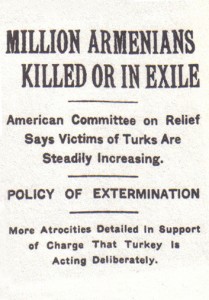Sun 8 Mar, 2009
The Armenian genocide and historical amnesia
Comment now Filed under: HistoryTags: Armenia, Armenian genocide, Genocide, Turkey
 One of the main themes of Traces of the Trade is the historical amnesia affecting memories of slavery and the slave trade in the United States, especially in the North.
One of the main themes of Traces of the Trade is the historical amnesia affecting memories of slavery and the slave trade in the United States, especially in the North.
It’s not just that far too many Americans do not know the basic history of slavery in our country, and therefore the extent of its legacy today. All too often, Americans are secure and confident in their knowledge of a version of history which is demonstrably false: that slavery was primarily a southern, agricultural phenomenon; that slavery was not economically important in the North; that an abolitionist North fought to end slavery; and that slavery’s economic impact died out after the Civil War.
There is an article in tomorrow’s edition of the New York Times which reports on lingering amnesia about another historical atrocity: the Turkish genocide in Armenia during World War I.
The scope of the Armenian genocide has long been a subject of dispute, particularly between scholars in Turkey and Armenia. The Turkish government has routinely claimed that only 300,000 Armenians died during the forced deportations in 1915-16, while independent historians more commonly cite figures of 600,000 to 1 million dead (with the rest of the pre-war population of some 1.8 million exiled or in hiding).
In Turkey, the subject of the Armenian genocide has been thoroughly repressed. For generations, the massacre has been edited out of schoolbooks and official histories, leaving few Turks with any knowledge of the subject.
Until about ten ago, in fact, the Times reports that “most Turks knew nothing of the details of the Armenian genocide.” In the last decade, however, there has been increasing discussion of the genocide in certain circles in Turkish society, culminating in December with a petition circulated by Turkish intellectuals and signed by some 29,000 people.
In January, however, a book was published in Turkey which cited the dramatic figure of 972,000 Armenians who disappeared from official population records. The book, by Murat Bardakci, compiled documents which had belonged to Talat Pasha, the Ottoman interior minister at the time, who was often described as the architect of the genocide.
As the Times story notes, “For Turkey, the number should have been a bombshell.”
In Turkey, any discussion of what happened to the Ottoman Armenians can bring a storm of public outrage. But since its publication in a book in January, the number — and its Ottoman source — has gone virtually unmentioned. Newspapers hardly wrote about it. Television shows have not discussed it.
“Nothing,” said Murat Bardakci, the Turkish author and columnist who compiled the book.
This figure does not substantially change historical accounts of the Armenian genocide outside of Turkey, and inside Turkey, it says nothing directly about deaths, much less whether those deaths were the result of a deliberate policy of exterminating Armenians, as most historians believe.
Yet the dramatic silence from Turkish society, in the face of a statistic which puts the lie to Turkish accounts of the era, suggests that that historical amnesia can be quite difficult to overcome. When the public understanding of history is challenged, especially in a way that threatens the public sense of itself as a people or a nation, the result can be sheer denial.
As Bardakci himself suggests, “My numbers are too high for ordinary people. Maybe people aren’t ready to talk about it yet.”